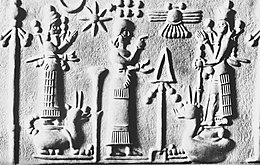Nabu
| Nabû | |
|---|---|
 Colossal statue of the god Nabu, 8th century BC, from Nimrud, on display in theNational Museum of Iraq | |
| Abode | Borsippa |
| Planet | Mercury |
| Symbol | Claytablet andstylus |
| Parents | MardukandSarpanitum |
| Consort | Tashmet |
| Equivalents | |
| Greek equivalent | Hermes |
| Roman equivalent | Mercury |
| Egyptian equivalent | Thoth |
| Norse equivalent | Odin |
| Mandaean equivalent | Nbu |

| Part ofa serieson |
| Ancient Mesopotamian religion |
|---|
 |
|
|
| Part of themyth serieson |
| Religions of the ancient Near East |
|---|
| Pre-Islamic Arabian deities |
| Arabian deities of other Semitic origins |
Nabu(Akkadian:cuneiform: 𒀭𒀝 Nabû,[1]Jewish Babylonian Aramaic:נְבוֹ,romanized:Nəḇo[2]) is theBabylonian patron godofliteracy,therational arts,scribes,andwisdom.He is associated with theclassical planetMercuryinBabylonian astronomy.[3]
Etymology and meaning[edit]
The Akkadiannabûmeans "announcer" or "authorised person",[4]derived from theSemitic rootn-b-yornbʾ.[5]It is cognate withClassical Syriac:ܢܒܝܐ,romanized:nəḇiyyā,Arabic:نبي,romanized:nabiyy,andHebrew:נביא,romanized:nāḇi,[6]all meaning 'prophet'.
History[edit]
Nabu was worshiped by the Babylonians and the Assyrians.[7]Nabu gained prominence among the Babylonians in the 1st millennium BC when he was identified as the son of the godMarduk.[7]
Nabu was worshipped in Babylon's sister cityBorsippa,from where his statue was taken to Babylon each New Year so that he could pay his respects to his father.[7]Nabu's symbols included a stylus resting on a tablet as well as a simple wedge shape; KingNabonidus,whose name references Nabu, had a royal sceptre topped with Nabu's wedge.[7][8]: 33–34 Clay tablets with especial calligraphic skill were used as offerings at Nabu's temple. His wife was theAkkadiangoddessTashmet.[7]
Nabu was the patron god of scribes, literacy, and wisdom.[7]He was also the inventor of writing, adivine scribe,the patron god of the rational arts, and a god of vegetation.[8]: 33–34 [9]As the god of writing, Nabu inscribed the fates assigned to men and he was equated with the scribe godNinurta.[9][10]As an oracle he was associated with the Mesopotamian moon godSin.[8]: 33–34 In the Babylonian tradition, planet Mercury was connected with Ninurta (as well asSaturn); because in theMUL.APINNinurta is consistently identified with Mercury,[11][12][13]and it is read that: "Mercury whose name is Ninurta travels the (same) path the Moon travels." As Marduk took over the role ofKing of the godsfromEnliland inherited both his cultic roles and epithets as well as his position within thepantheon– the role of the most important son of the father of the gods that had previously belonged to Ninurta as son of Enlil (now replaced by Marduk); was thus taken over by Nabu, and Nabu became associated with the planet Mercury as well as being given connections with the moon god Sin, because as addressed in the MUL.APIN – even when Mercury was considered the planet of Ninurta, it still retained some moon-like aspects since it traveled the same path of the moon.
Nabu wore a horned cap, and stood with his hands clasped in the ancient gesture of priesthood. He rode on a wingeddragonknown asSirrushthat originally belonged to his father Marduk. InBabylonian astrology,Nabu was identified with the planetMercury.[14][15]
Nabu was continuously worshipped until the 2nd century, whencuneiformbecame a lost art.[7]
Today inMandaean cosmology,the name forMercuryisʻNbu(ࡏࡍࡁࡅ), which is derived from the name Nabu.[16]
Outside Mesopotamia[edit]
Nabu'scultspread toancient Egypt.[17]Names with Nabu in them are the most commontheophoricnames for Semitic speakers in Egypt as it was in the Neo-Babylonian texts.[18]Nabu was also one of the Canaanite and Israelite deities worshipped inElephantineandAswanalongside gods likeYahweh,Nanay,Bethel,Anat,and theQueen of Heaven.[19]
In theHebrew Bible,Nabu is mentioned asNəḇo(נְבוֹ) inIsaiah 46:1andJeremiah 48:1.[7][20][21]
In the Hellenistic period, Nabu was sometimes identified withApolloas a giver of prophecies.[7][8]: 71 As the god of wisdom and a divine messenger, Nabu was linked with the Greek godHermes,the Roman godMercury,and the Egyptian deityThoth.[8]: 71
References[edit]
- ^Lanfranchi, Giovanni B. (1987).The Correspondence of Sargon II.Helsinki: Helsinki University Press. p. 92.ISBN9515700043.
- ^"The Comprehensive Aramaic Lexicon".cal.huc.edu.
- ^"The Comprehensive Aramaic Lexicon".cal.huc.edu.
- ^Richter, Thomas (2006)."Nabû".Brill’s New Pauly.Brill.Retrieved2022-10-14.
- ^"Semitic Roots Appendix".The American Heritage Dictionary.Retrieved6 December2019.
nbʾ To name, proclaim, summon. "
- ^p.1571, Alcalay. An alternative translation of this Hebrew word is derived from an Akkadian word "Nabu," meaning to call. The Hebrew "Navi" has a passive sense and means "the one who has been called" (see HALOT, p.661).
- ^abcdefghiBertman, Stephen (2005).Handbook to Life in Ancient Mesopotamia(Paperback ed.). Oxford:Oxford University Press.p. 122.ISBN9780195183641.Retrieved2016-08-08.
- ^abcdeGreen, Tamara M. (1992).The City of the Moon God: Religious Traditions of Harran.Leiden:Brill Publishers.ISBN9004095136.Retrieved2017-01-04.
- ^ab"Nabu".Encyclopedia Britannica.Archived fromthe originalon July 2, 2016.RetrievedAugust 4,2019.
- ^Leick, Dr Gwendolyn (2002).A Dictionary of Ancient Near Eastern Mythology.Routledge.p. 124.ISBN9781134641024.RetrievedMarch 7,2019.
- ^Koch 1995,p. 127.
- ^Hunger & Steele 2018,p. 127.
- ^Horowitz 1998,p. 172.
- ^Colligan, L. H. (January 15, 2010).Mercury.Marshall Cavendish.p.22.ISBN9780761445517.RetrievedMarch 7,2019.
- ^Lewis, James R. (Mar 1, 2003).The Astrology Book: The Encyclopedia of Heavenly Influences(Second ed.).Visible Ink Press.p. 442.ISBN9781578593019.RetrievedMarch 7,2019.
- ^Bhayro, Siam (10 February 2020). "Cosmology in Mandaean Texts".Hellenistic Astronomy.Leiden:Brill Publishers.pp. 572–579.doi:10.1163/9789004400566_046.ISBN9789004243361.S2CID213438712.Retrieved8 February2022.
- ^Porten, Bezalel (1968).Archives from Elephantine: The Life of an Ancient Jewish Military Colony(First ed.).University of California Press.p. 166.ISBN9780520010284.RetrievedOctober 4,2019.
- ^Porten, Bezalel; Zadok, Ran; Pearce, Laurie (2016). "Akkadian Names in Aramaic Documents from Ancient Egypt".Bulletin of the American Schools of Oriental Research.375:2.
- ^Toorn, Karel van der (24 September 2019).Becoming Diaspora Jews: Behind the Story of Elephantine.Yale University Press.ISBN978-0-300-24949-1.
- ^"Isaiah 46:1 NIV – Gods of Babylon – Bel bows down, Nebo".BibleGateway.Retrieved2015-06-23.
- ^"Jeremiah 48:1 NIV – A Message About Moab – Concerning Moab".BibleGateway.Retrieved2015-07-02.
Bibliography[edit]
- Horowitz, Wayne (1998).Mesopotamian Cosmic Geography.Eisenbrauns.ISBN978-0931464997.
- Hunger, Hermann; Steele, John (2018).The Babylonian Astronomical Compendium MUL.APIN.Taylor & Francis.ISBN978-1351686815.
- Koch, Ulla Susanne (1995).Mesopotamian astrology: an introduction to Babylonian and Assyrian celestial divination.Museum Tusculanum Press.ISBN978-8772892870.
